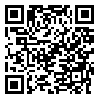Volume 15, Issue 1 (8-2025)
Clin Exc 2025, 15(1): 95-106 |
Back to browse issues page
Download citation:
BibTeX | RIS | EndNote | Medlars | ProCite | Reference Manager | RefWorks
Send citation to:



BibTeX | RIS | EndNote | Medlars | ProCite | Reference Manager | RefWorks
Send citation to:
Azimi-Amiri Z, Babaie M, Rahimi-Esbo S, Gholinia-Ahangar H, Ghaemi-amiri M. Evaluation of the Clinical Education Environment of Babol University of Medical Sciences from the Perspective of Medical Students based on the DREEM Model. Clin Exc 2025; 15 (1) :95-106
URL: http://ce.mazums.ac.ir/article-1-902-en.html
URL: http://ce.mazums.ac.ir/article-1-902-en.html
Zahra Azimi-Amiri 

 , Mansour Babaie
, Mansour Babaie 

 , Sobhan Rahimi-Esbo
, Sobhan Rahimi-Esbo 

 , Hemmant Gholinia-Ahangar
, Hemmant Gholinia-Ahangar 

 , Maryam Ghaemi-amiri
, Maryam Ghaemi-amiri 




 , Mansour Babaie
, Mansour Babaie 

 , Sobhan Rahimi-Esbo
, Sobhan Rahimi-Esbo 

 , Hemmant Gholinia-Ahangar
, Hemmant Gholinia-Ahangar 

 , Maryam Ghaemi-amiri
, Maryam Ghaemi-amiri 


Social Determinants of Health Research Center, Health Research Institute, Education Development Center, Babol University of Medical Science, Babol, Iran.
Abstract: (869 Views)
Background and purpose: Clinical education is a fundamental part of medical education that is essential for training efficient and competent individuals. The learning environment has a significant impact on students' motivation, satisfaction, and performance. Evaluating the clinical educational environment helps identify strengths and weaknesses and provides opportunities to improve the quality of education. The present study evaluated the clinical educational environment at Babol University of Medical Sciences from the perspective of medical students based on the DREEM model.
Materials and Methods: This descriptive-cross-sectional study was conducted among medical students at Babol University of Medical Sciences. The data collection tool was the standard questionnaire, the "Dundee Ready Educational Environment Measure" (DREEM), which contains 50 items across five areas: students' perception of learning, professors, their own academic ability, educational atmosphere, and social conditions. The questionnaire score ranged from 0 to 200, with a higher score indicating a more favorable perception of the educational environment. The data were analyzed using SPSS software version 26 and both descriptive and inferential statistics methods.
Results: The overall score of the DREEM questionnaire indicated that students' views on the clinical learning environment were generally positive (131.43 out of 200); however, some areas needed improvement. The highest score was related to students' perception of their academic competence, which reflects their confidence in their learning abilities. In contrast, the lowest score was assigned to the perception of social conditions, indicating challenges in the social aspects of the learning environment. Differences in views were also observed based on demographic factors, highlighting the need for targeted interventions.
Conclusion: The results of the study indicate that, although the clinical learning environment at Babol University of Medical Sciences is generally evaluated positively, improvements are needed, especially in the areas of social support and social interactions. Continuous assessment and targeted improvement of these areas can enhance the learning experience and educational outcomes for students. Regular use of the DREEM model can help provide valuable insights to educational planners to improve the clinical learning environment.
Materials and Methods: This descriptive-cross-sectional study was conducted among medical students at Babol University of Medical Sciences. The data collection tool was the standard questionnaire, the "Dundee Ready Educational Environment Measure" (DREEM), which contains 50 items across five areas: students' perception of learning, professors, their own academic ability, educational atmosphere, and social conditions. The questionnaire score ranged from 0 to 200, with a higher score indicating a more favorable perception of the educational environment. The data were analyzed using SPSS software version 26 and both descriptive and inferential statistics methods.
Results: The overall score of the DREEM questionnaire indicated that students' views on the clinical learning environment were generally positive (131.43 out of 200); however, some areas needed improvement. The highest score was related to students' perception of their academic competence, which reflects their confidence in their learning abilities. In contrast, the lowest score was assigned to the perception of social conditions, indicating challenges in the social aspects of the learning environment. Differences in views were also observed based on demographic factors, highlighting the need for targeted interventions.
Conclusion: The results of the study indicate that, although the clinical learning environment at Babol University of Medical Sciences is generally evaluated positively, improvements are needed, especially in the areas of social support and social interactions. Continuous assessment and targeted improvement of these areas can enhance the learning experience and educational outcomes for students. Regular use of the DREEM model can help provide valuable insights to educational planners to improve the clinical learning environment.
Type of Study: Research(Original) |
Subject:
آموزش پزشكی
Received: 2025/04/22 | Accepted: 2025/08/9 | Published: 2025/08/9
Received: 2025/04/22 | Accepted: 2025/08/9 | Published: 2025/08/9
Send email to the article author
| Rights and permissions | |
 |
This work is licensed under a Creative Commons Attribution-NonCommercial 4.0 International License. |



